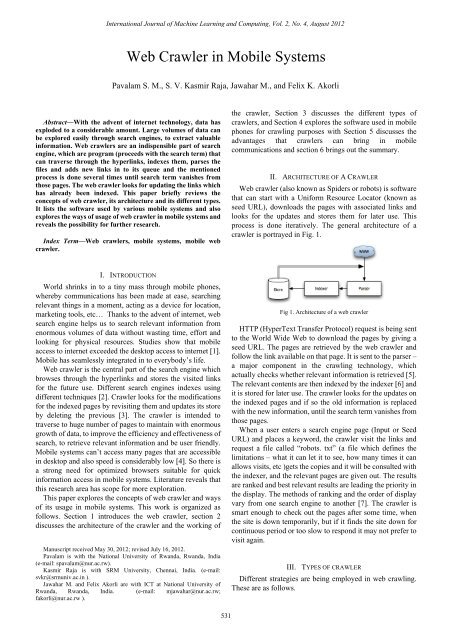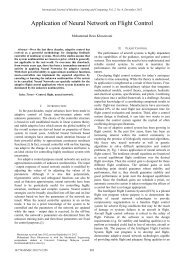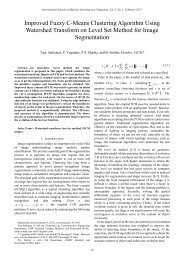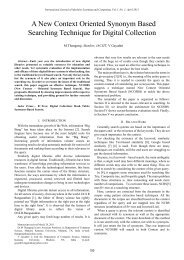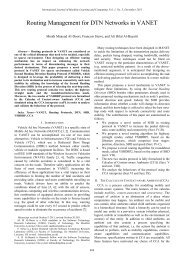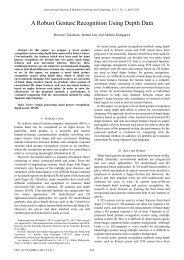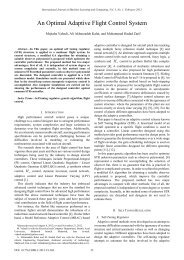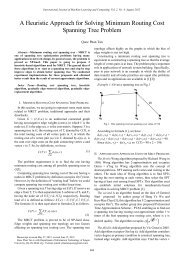Web Crawler in Mobile Systems - ijmlc
Web Crawler in Mobile Systems - ijmlc
Web Crawler in Mobile Systems - ijmlc
You also want an ePaper? Increase the reach of your titles
YUMPU automatically turns print PDFs into web optimized ePapers that Google loves.
International Journal of Mach<strong>in</strong>e Learn<strong>in</strong>g and Comput<strong>in</strong>g, Vol. 2, No. 4, August 2012<strong>Web</strong> <strong>Crawler</strong> <strong>in</strong> <strong>Mobile</strong> <strong>Systems</strong>Pavalam S. M., S. V. Kasmir Raja, Jawahar M., and Felix K. AkorliAbstract—With the advent of <strong>in</strong>ternet technology, data hasexploded to a considerable amount. Large volumes of data canbe explored easily through search eng<strong>in</strong>es, to extract valuable<strong>in</strong>formation. <strong>Web</strong> crawlers are an <strong>in</strong>dispensible part of searcheng<strong>in</strong>e, which are program (proceeds with the search term) thatcan traverse through the hyperl<strong>in</strong>ks, <strong>in</strong>dexes them, parses thefiles and adds new l<strong>in</strong>ks <strong>in</strong> to its queue and the mentionedprocess is done several times until search term vanishes fromthose pages. The web crawler looks for updat<strong>in</strong>g the l<strong>in</strong>ks whichhas already been <strong>in</strong>dexed. This paper briefly reviews theconcepts of web crawler, its architecture and its different types.It lists the software used by various mobile systems and alsoexplores the ways of usage of web crawler <strong>in</strong> mobile systems andreveals the possibility for further research.Index Term—<strong>Web</strong> crawlers, mobile systems, mobile webcrawler.the crawler, Section 3 discusses the different types ofcrawlers, and Section 4 explores the software used <strong>in</strong> mobilephones for crawl<strong>in</strong>g purposes with Section 5 discusses theadvantages that crawlers can br<strong>in</strong>g <strong>in</strong> mobilecommunications and section 6 br<strong>in</strong>gs out the summary.II. ARCHITECTURE OF A CRAWLER<strong>Web</strong> crawler (also known as Spiders or robots) is softwarethat can start with a Uniform Resource Locator (known asseed URL), downloads the pages with associated l<strong>in</strong>ks andlooks for the updates and stores them for later use. Thisprocess is done iteratively. The general architecture of acrawler is portrayed <strong>in</strong> Fig. 1.I. INTRODUCTIONWorld shr<strong>in</strong>ks <strong>in</strong> to a t<strong>in</strong>y mass through mobile phones,whereby communications has been made at ease, search<strong>in</strong>grelevant th<strong>in</strong>gs <strong>in</strong> a moment, act<strong>in</strong>g as a device for location,market<strong>in</strong>g tools, etc… Thanks to the advent of <strong>in</strong>ternet, websearch eng<strong>in</strong>e helps us to search relevant <strong>in</strong>formation fromenormous volumes of data without wast<strong>in</strong>g time, effort andlook<strong>in</strong>g for physical resources. Studies show that mobileaccess to <strong>in</strong>ternet exceeded the desktop access to <strong>in</strong>ternet [1].<strong>Mobile</strong> has seamlessly <strong>in</strong>tegrated <strong>in</strong> to everybody’s life.<strong>Web</strong> crawler is the central part of the search eng<strong>in</strong>e whichbrowses through the hyperl<strong>in</strong>ks and stores the visited l<strong>in</strong>ksfor the future use. Different search eng<strong>in</strong>es <strong>in</strong>dexes us<strong>in</strong>gdifferent techniques [2]. <strong>Crawler</strong> looks for the modificationsfor the <strong>in</strong>dexed pages by revisit<strong>in</strong>g them and updates its storeby delet<strong>in</strong>g the previous [3]. The crawler is <strong>in</strong>tended totraverse to huge number of pages to ma<strong>in</strong>ta<strong>in</strong> with enormousgrowth of data, to improve the efficiency and effectiveness ofsearch, to retrieve relevant <strong>in</strong>formation and be user friendly.<strong>Mobile</strong> systems can’t access many pages that are accessible<strong>in</strong> desktop and also speed is considerably low [4]. So there isa strong need for optimized browsers suitable for quick<strong>in</strong>formation access <strong>in</strong> mobile systems. Literature reveals thatthis research area has scope for more exploration.This paper explores the concepts of web crawler and waysof its usage <strong>in</strong> mobile systems. This work is organized asfollows. Section 1 <strong>in</strong>troduces the web crawler, section 2discusses the architecture of the crawler and the work<strong>in</strong>g ofManuscript received May 30, 2012; revised July 16, 2012.Pavalam is with the National University of Rwanda, Rwanda, India(e-mail: spavalam@nur.ac.rw).Kasmir Raja is with SRM University, Chennai, India. (e-mail:svkr@srmuniv.ac.<strong>in</strong> ).Jawahar M. and Felix Akorli are with ICT at National University ofRwanda, Rwanda, India. (e-mail: mjawahar@nur.ac.rw;fakorli@nur.ac.rw ).Fig 1. Architecture of a web crawlerHTTP (HyperText Transfer Protocol) request is be<strong>in</strong>g sentto the World Wide <strong>Web</strong> to download the pages by giv<strong>in</strong>g aseed URL. The pages are retrieved by the web crawler andfollow the l<strong>in</strong>k available on that page. It is sent to the parser –a major component <strong>in</strong> the crawl<strong>in</strong>g technology, whichactually checks whether relevant <strong>in</strong>formation is retrieved [5].The relevant contents are then <strong>in</strong>dexed by the <strong>in</strong>dexer [6] andit is stored for later use. The crawler looks for the updates onthe <strong>in</strong>dexed pages and if so the old <strong>in</strong>formation is replacedwith the new <strong>in</strong>formation, until the search term vanishes fromthose pages.When a user enters a search eng<strong>in</strong>e page (Input or SeedURL) and places a keyword, the crawler visit the l<strong>in</strong>ks andrequest a file called “robots. txt” (a file which def<strong>in</strong>es thelimitations – what it can let it to see, how many times it canallows visits, etc )gets the copies and it will be consulted withthe <strong>in</strong>dexer, and the relevant pages are given out. The resultsare ranked and best relevant results are lead<strong>in</strong>g the priority <strong>in</strong>the display. The methods of rank<strong>in</strong>g and the order of displayvary from one search eng<strong>in</strong>e to another [7]. The crawler issmart enough to check out the pages after some time, whenthe site is down temporarily, but if it f<strong>in</strong>ds the site down forcont<strong>in</strong>uous period or too slow to respond it may not prefer tovisit aga<strong>in</strong>.III. TYPES OF CRAWLERDifferent strategies are be<strong>in</strong>g employed <strong>in</strong> web crawl<strong>in</strong>g.These are as follows.531
International Journal of Mach<strong>in</strong>e Learn<strong>in</strong>g and Comput<strong>in</strong>g, Vol. 2, No. 4, August 2012A. Focused <strong>Web</strong> <strong>Crawler</strong>A Focused web crawler returns pages which are specificand relevant to the given topic. The focused crawlerdeterm<strong>in</strong>es the follow<strong>in</strong>g – Relevancy, Way forward. Itdeterm<strong>in</strong>es how far the given page is relevant to the particulartopic and how to proceed forward [8]. The advantage offocused web crawler is that it is economically feasible <strong>in</strong>terms of hardware and network resources and also its searchexposure is huge [9]. It employs the different techniques forsearch<strong>in</strong>g. Certa<strong>in</strong> focused crawlers employ Best – Fit searchstrategy. Some focused crawler employs page rank techniquefor giv<strong>in</strong>g out the most important page [10]. Others usesneural net, back propagation to f<strong>in</strong>d the most relevant [11].Several other techniques are be<strong>in</strong>g used for focused crawl<strong>in</strong>g[12].B. Incremental <strong>Crawler</strong>An <strong>in</strong>cremental crawler is one which updates its <strong>in</strong>dexcollection on an <strong>in</strong>cremental basis after its targetaccumulation is f<strong>in</strong>ally reached and based on an estimate [13].It refreshes the exist<strong>in</strong>g collection by new updations on aperiodical basis [14]. It helps to save network bandwidth andalso effective [15]. Several approaches [16], [17], [18], [19]has been used.C. Distributed <strong>Crawler</strong>Many crawlers are employed to distribute <strong>in</strong> the process ofweb crawl<strong>in</strong>g, <strong>in</strong> order to have the most coverage of the web.A central server manages the communication andsynchronization of the nodes, as it is geographicallydistributed [20]. It needs <strong>in</strong>creased computer nodes andstorage capability to <strong>in</strong>crease crawl<strong>in</strong>g efficiency [21]. Itbasically uses Page rank algorithm for its <strong>in</strong>creasedefficiency and quality search [22]. There have been manyother approaches [23], [24, [25], [26] which are proposed.D. Parallel <strong>Crawler</strong>Multiple crawlers are often run <strong>in</strong> parallel, which arereferred as Parallel crawlers [27]. The Parallel crawlersdepend on Page freshness and Page Selection [28]. A Parallelcrawler can be on local network or be distributed atgeographically distant locations [29]. [30], [27], [31] haveproposed <strong>in</strong>terest<strong>in</strong>g and different methods for achiev<strong>in</strong>ghigh performance and effective memory usage.IV. SOFTWARE USED IN WEB CRAWLINGIn this section we <strong>in</strong>tend to present the software which isused <strong>in</strong> different mobile systems. The basic underly<strong>in</strong>gtechnologies are HTML, XHTML, WAP, WML, CSS,ECMA Script.TABLE I: BROWSERS IN VARIOUS MOBILE SYSTEMSBrowser Orig<strong>in</strong> Used <strong>in</strong>Polaris BrowserInfraware Inc.K<strong>in</strong>dle Basic <strong>Web</strong> Amazon.com BlackberryNokia, Samsung, LGElectronics, KYOCERA andother Smartphone and cellularphone <strong>in</strong> USA, Ch<strong>in</strong>a, Korea, etcAndroid browser Google Nexus<strong>Web</strong>OS Browser Palm -BlackBerry BrowserBlazerResearch <strong>in</strong>MotionPalm-<strong>in</strong>stalled on all newerPalm Treos and PDAsFirefox for mobile Mozilla Nokia Maemo and for AndroidInternet Explorer <strong>Mobile</strong> Microsoft Samsung newer versionsIris BrowserMyriad Browser(Previously Openwave<strong>Mobile</strong> Browser)NetFrontTorch <strong>Mobile</strong>Inc.Myriad GroupACCESS Co.,Ltd.Nokia Series 40 Browser Nokia -Acquired by Research <strong>in</strong>Motion - No longer supportsW<strong>in</strong>dows <strong>Mobile</strong> or L<strong>in</strong>uxAcquired from Openwave <strong>in</strong>2008Obigo Browser Obigo AB 100% owned by Teleca ABOpera <strong>Mobile</strong>PlayStation Portable webbrowserOperaSoftwareSony-Capable of read<strong>in</strong>g HTML andreformat for small screens,<strong>in</strong>stalled on many phonesSony PSPSafari Apple Inc on iPhone, iPod Touch and iPadSkyfire <strong>Mobile</strong> BrowseruZard <strong>Web</strong>xScopeSkyfireLogicplantCo., Ltd.xScope<strong>Mobile</strong>Renders Flash 10, Ajax andSilverlight content. supportsW<strong>in</strong>dows <strong>Mobile</strong> 5/6.x,SymbianS60 and Android.on Samsung, LGElectronics and othersmartphones and cellular phones<strong>in</strong> Koreaon android systemsTable I lists the compilation of various browsers <strong>in</strong> use bydifferent <strong>Mobile</strong> systems from the web.V. APPLICATIONS OF CRAWLER IN MOBILE SYSTEMSA. <strong>Mobile</strong> Learn<strong>in</strong>geLearn<strong>in</strong>g is a technology, which helps learn<strong>in</strong>g to takeplace at user paced and also fitt<strong>in</strong>g their <strong>in</strong>terest and level ofunderstand<strong>in</strong>g [32]. In eLearn<strong>in</strong>g Learners are exposed with awide variety of resources for education, whereby the relevantmaterial is found by crawl<strong>in</strong>g through the web [33]. It alsoenhances <strong>in</strong> Human – computer <strong>in</strong>teraction [34]. <strong>Web</strong> m<strong>in</strong><strong>in</strong>gtechniques like web logs, web usage m<strong>in</strong><strong>in</strong>g could help toextract the <strong>in</strong>terests of the learners and help to improve thelearn<strong>in</strong>g environment. The <strong>Mobile</strong> Learn<strong>in</strong>g is an extendedconcept of eLearn<strong>in</strong>g through mobile means. Research [35]shows mobile could be an excellent tool <strong>in</strong> <strong>in</strong>stigat<strong>in</strong>glearn<strong>in</strong>g process. Digital libraries act as a vital tool <strong>in</strong> thelearn<strong>in</strong>g process.B. <strong>Mobile</strong> Commerce<strong>Mobile</strong> commerce is the application of wireless technologyto the <strong>in</strong>dustry of commerce. <strong>Mobile</strong> commerce applicationsare hav<strong>in</strong>g a wide coverage. Some of them are mobileadvertisement, mobile bank<strong>in</strong>g, mobile location f<strong>in</strong>der,532
International Journal of Mach<strong>in</strong>e Learn<strong>in</strong>g and Comput<strong>in</strong>g, Vol. 2, No. 4, August 2012mobile shopp<strong>in</strong>g [36]. <strong>Mobile</strong> advertisement serves as meansof advertisement targeted to the people on specific locationthrough mobile devices (for example <strong>in</strong>formation aboutoffers sale for products perta<strong>in</strong>ed to a specific locationpeople). <strong>Mobile</strong> bank<strong>in</strong>g is the most popular and economicalmeans of transaction services through the mobile phoneswhich helps to improve the quality of services and bus<strong>in</strong>essprocesses. <strong>Mobile</strong> serves as a geographic location f<strong>in</strong>derwhich adds significant importance by giv<strong>in</strong>g <strong>in</strong>formationavailable <strong>in</strong> that particular area. Shopp<strong>in</strong>g is an <strong>in</strong>tegral partof human life and mobile adds significant value by giv<strong>in</strong>g the<strong>in</strong>formation for the queried products as well as relevantproducts, which helps sav<strong>in</strong>g time and energy. [37] Showsthe disposition of people on this mobile technology.C. Social Relations<strong>Mobile</strong> plays a major role <strong>in</strong> establish<strong>in</strong>g and ma<strong>in</strong>ta<strong>in</strong><strong>in</strong>gsocial relationships. Social network<strong>in</strong>g helps the users toconnect virtually at all times, leav<strong>in</strong>g beh<strong>in</strong>d the feel<strong>in</strong>g ofdisconnected from the social activities of life, even <strong>in</strong> theirbusy lifestyle. It covers a wider range of applications <strong>in</strong>mobile - simple text messag<strong>in</strong>g, mobile communication,connect<strong>in</strong>g to a large network of specific <strong>in</strong>terests (ex:facebook), active email alerts, analyz<strong>in</strong>g the potentialcustomers of the future and E-Governance [38], [39].VI. SUMMARYThis paper gave a snapshot of <strong>Web</strong> Crawl<strong>in</strong>g aspects, itsarchitecture and its techniques. It also explored the differentsoftware used <strong>in</strong> brows<strong>in</strong>g <strong>in</strong> mobile. The overview presented<strong>in</strong> this paper shows web crawler has a significant scope on the<strong>Mobile</strong> systems. We then proceeded to explore somepotential applications of web crawler <strong>in</strong> the Learn<strong>in</strong>g field,commercial field and Social relationship. In clos<strong>in</strong>g the scopeof <strong>Web</strong> <strong>Crawler</strong> <strong>in</strong> <strong>Mobile</strong> needs to be explored further.REFERENCES[1] International Telecommunications union, “The world <strong>in</strong> 2009: ICTfacts and figures” presented at ITU Telecom world2009 Geneva, Oct.2009.[2] Stefan Buttcher, Charles L. A. Clarke, and Gordon V Cormack,“Information Retrieval” MIT Press, 2010, ch I.2, pp. 40-50.[3] Sat<strong>in</strong>der Bal and Rajender Nath, “A Novel Approach to FilterNon-Modified pages at remote site without download<strong>in</strong>g dur<strong>in</strong>gcrawl<strong>in</strong>g” Proc. International Conference on Advances <strong>in</strong> RecentTechnologies <strong>in</strong> Communication and Comput<strong>in</strong>g 2009 (ARTCom 2009),IEEE, pp. 165 – 169.[4] Arie van der Dussen, Elizabeth Burd “Reverse Eng<strong>in</strong>eer<strong>in</strong>g” IEEEComputer society, 2002, ch 1, pp14-16.[5] N. A. El-Ramly, H. M. Harb, M. Am<strong>in</strong>, and A. M.Tolba, “MoreEffective, Efficient, Scalable <strong>Web</strong> <strong>Crawler</strong> Architecture” Proc ofElectrical, Electronic and Computer Eng<strong>in</strong>eer<strong>in</strong>g, 2004. ICEEC '04,pp. 120-123.[6] Muhammad shoaib and Shazia Arshad, “Design and implementation ofweb <strong>in</strong>formation gather<strong>in</strong>g system” Second National InformationTechnology Symposium (NITS 2007), CCIS, paper 142 – 1.[7] Mohammed Khan “Search Eng<strong>in</strong>e Optimization – what do you need toknow” SEO expert, 2008, pp. 22.[8] AH Chung Tsol, Daniele Forsali, Marco Gori, Markus Hagenbuchner,Franco Scarselli, “A Simple Focused <strong>Crawler</strong>” Proc 12 th InternationalWWW Conference 2003(poster), pp. 1.[9] Soumen Chakrabarti, Mart<strong>in</strong> van den Berg, and Byron Dom “Focusedcrawl<strong>in</strong>g: a new approach to topic-specific <strong>Web</strong> resource discovery”Proc of 8 th <strong>in</strong>ternational WWW conference (WWW8), Toronto ’99, pp.545 – 562.[10] Junghoo Cho, Hector Garcia-Mol<strong>in</strong>a, Lawrence Page "EfficientCrawl<strong>in</strong>g Through URL Order<strong>in</strong>g", Proc of the 7th InternationalWWW Conference, 1998, pp. 161-172.[11] Gatial E., Balogh Z., Laclavik M., Ciglan M. and Hluchy L. “ Focused<strong>Web</strong> Crawl<strong>in</strong>gMechanism based on Page Relevance” Proc ITAT 2005Information Technologies - Applications and Theory, Peter Vojtas(Ed.), pp.41-46.[12] Hai Dong, Farookh Khadeer Hussa<strong>in</strong>, and Elizabeth Chang, "A Survey<strong>in</strong> Semantic <strong>Web</strong> Technologies-Inspired Focused <strong>Crawler</strong>s", ProcICDIM 2008, pp. 934 – 936.[13] A. K. Sharma and Ashutosh Dixit, “Self Adjust<strong>in</strong>g Refresh Time BasedArchitecture for Incremental <strong>Web</strong> <strong>Crawler</strong>” International Journal ofComputer Science and Network Security, vol.8 no.12, 2008, pp.349-354[14] Niraj S<strong>in</strong>ghal, Ashutosh Dixit, and Dr. A. K. Sharma “Design of aPriority Based Frequency Regulated Incremental <strong>Crawler</strong>”International Journal of Computer Applications (0975 – 8887) vol.1,no. 1, 2010, pp. 42-47.[15] Junghoo Cho and Hector Garcia-Mol<strong>in</strong>a, “The Evolution of the <strong>Web</strong>and Implications for an <strong>in</strong>cremental <strong>Crawler</strong>” Proc VLDB Conference,2000, pp. 200 – 209.[16] Q<strong>in</strong>gzhao Tan and Prasenjit Mitra, “Cluster<strong>in</strong>g-based Incremental<strong>Web</strong>Crawl<strong>in</strong>g” ACM Transactions on Information <strong>Systems</strong>, vol. 2, no. 3, 032010, pp. 1–25.[17] Wei Liu, Jianguo Xiao, and Jianwu Yang, “A Sample-GuidedApproach to Incremental Structured <strong>Web</strong> Database Crawl<strong>in</strong>g” ProcIEEE International Conference on Information and Automation 2010,IEEE, pp. 890-895[18] Christos Bouras, Vassilis Poulopoulos, and Athena Thanou “ Creat<strong>in</strong>gA Polite, Adaptive And Selective Incremental <strong>Crawler</strong>” ProcInternational Conference WWW/INTERNET 2005, Portugal, vol. I,pp.307-314.[19] Jiang-M<strong>in</strong>g Yang, Rui Cai, Chunsong Wang, Hua Huang, Lei Zhang,and Wei-Y<strong>in</strong>g Ma “Incorporat<strong>in</strong>g Site-Level Knowledge forIncremental Crawl<strong>in</strong>g of <strong>Web</strong> Forums: A List-wise Strategy”Proceed<strong>in</strong>gs of the 15th ACM SIGKDD <strong>in</strong>ternational conference onKnowledge discovery and data m<strong>in</strong><strong>in</strong>g KDD’09, 2009, Paris,pp1375-1384[20] Kunpeng Zhu, Zhim<strong>in</strong>g Xu, Xiaolong Wang, and Yum<strong>in</strong>g Zhao, “AFull Distributed <strong>Web</strong> <strong>Crawler</strong> Based on Structured Network”: AIRS2008, Lecture Notes <strong>in</strong> Computer Science , H. Li et al. (Eds.), pp.478–483[21] Jos´e E x p o s to, Joaquim Macedo, A n t´onio P<strong>in</strong>a, Albano Alves,andJos´e Ruf<strong>in</strong>o, “Efficient Partition<strong>in</strong>g Strategies for Distributed <strong>Web</strong>Crawl<strong>in</strong>g” ICOIN 2007, 2008, Lecture Notes <strong>in</strong> Computer Science , T.Vaz˜ao, M.M. Freire, and I. Chong (Eds.), pp. 544–553.[22] S. Br<strong>in</strong> and L. Page “ The Anatomy of a Large Scale Hypertextual websearch eng<strong>in</strong>e” Proc. 7 th International world wide web conference,1998, pp. 107-117.[23] Marc Najork, Allan Heydon “Handbook of Massive Data Sets” (editedby J. Abello, P. Pardalos, and M. Resende), Kluwer AcademicPublishers, Inc., 2001, ch2, pp. 28-35.[24] Apostolos Kritikopoulos, Martha Sideri, and Kostant<strong>in</strong>os Stroggilos,“Crawl Wave: A Distributed <strong>Crawler</strong>,” Proc 3rd Hellenic Conferenceon Artificial IntelligenceSETN04, 2004, LNAI.[25] Kunpeng Zhu, Zhim<strong>in</strong>g Xu, Xiaolong Wang, and Yum<strong>in</strong>g Zhao “AFull Distributed <strong>Web</strong> <strong>Crawler</strong> Based On Structured Network” LectureNotes <strong>in</strong> Computer Science 2008, vol 4993/2008 pp. 478-483.[26] Paolo Boldi, Bruno Codenotti, Massimo Sant<strong>in</strong>i, and Sebastiano Vigna,“Ubi<strong>Crawler</strong>: a scalable fully distributed web crawler”,Software—Practice & Experience, 2004, vol.34 no.8, pp.711-726.[27] Shoub<strong>in</strong> Dong, Xiaofeng Lu, L<strong>in</strong>g Zhang and Kej<strong>in</strong>g He “An EfficientParallel <strong>Crawler</strong> In Grid Environment” Lecture Notes <strong>in</strong> ComputerScience 2004, vol. 3032/2004 pp. 229-232.[28] Junghoo Cho and Hector Garcia Mol<strong>in</strong>a “Parallel <strong>Crawler</strong>s” Proc. 11 th<strong>in</strong>ternational conference on world wide web WWW2002, pp.124-135.[29] Nidhi Tyagi and Deepti Gupta, “A Novel Architecture for Doma<strong>in</strong>Specific Parallel <strong>Crawler</strong>” Indian Journal of Computer Science andEng<strong>in</strong>eer<strong>in</strong>g, vol. 1 no. 1 44-53, pp. 44-53.[30] Divakar Yadav, AK Sharma, and J. P. Gupta “Parallel <strong>Crawler</strong>Architecture and <strong>Web</strong> Page Change Detection”, WSEAS TransactionsOn Computers, Issue 7, Volume 7, July 2008, pp929-940.[31] Mauricion Mar<strong>in</strong>, Rodrigo Paredes, and Carol<strong>in</strong>a Bonacic “HighPerformance Priority Queues For Parallel <strong>Crawler</strong>s” Proc. 10 th ACMWorkshop On <strong>Web</strong> Information And Data Management (WIDM’08),pp. 47-54.[32] Yevgen Biletskiy, Michael Wojcenovic, and Hamidreza Baghi,“Focused Crawl<strong>in</strong>g for Download<strong>in</strong>g Learn<strong>in</strong>g Objects – AnArchitectural Perspective” Interdiscipl<strong>in</strong>ary Journal of E-Learn<strong>in</strong>gand Learn<strong>in</strong>g Objects, Volume 5, 2009, pp. 169 – 180.533
International Journal of Mach<strong>in</strong>e Learn<strong>in</strong>g and Comput<strong>in</strong>g, Vol. 2, No. 4, August 2012[33] Julien Tane, Christoph Schmitz and Gerd Stumme, “SemanticResource Management for the <strong>Web</strong>:An ELearn<strong>in</strong>g Application” ProcWWW2004, pp. 1-10.[34] O. Shata, “A Personalized Multimedia <strong>Web</strong>-Based Educational Systemwith Automatic Index<strong>in</strong>g for Multimedia Courses” Proc WorldCongress on Eng<strong>in</strong>eer<strong>in</strong>g 2007 (WCE 2007), vol. I, pp. 269 – 273.[35] Kumar, L. S., Jamatia, B., and Aggarwal A. K., “<strong>Mobile</strong> phones aseffective learner support devices: A case study” Proc InternationalConference on Distance and Learn<strong>in</strong>g Education (ICDLE 2010), pp.211- 213.[36] Hao Huang, Lu Liu, and Jianjun Wang, “Diffusion of <strong>Mobile</strong>Commerce Application <strong>in</strong> the Market” Proc. Second InternationalConference on Innovative Comput<strong>in</strong>g, Information and Control, 2007.(ICICIC '07), pp. 485-488[37] Manochehri, N.-N. and AlH<strong>in</strong>ai, Y. S.,“<strong>Mobile</strong>-phone users’ attitudestowards’ mobile commerce & services <strong>in</strong> the Gulf CooperationCouncil countries: Case study” Proc International Conference onService <strong>Systems</strong> and Service Management, 2008 , pp. 1-6.[38] Georgios Lappas, “An Overview of <strong>Web</strong> M<strong>in</strong><strong>in</strong>g <strong>in</strong> Societal BenefitAreas” Proc The 9th IEEE International Conference on E-CommerceTechnology and The 4th IEEE International Conference on EnterpriseComput<strong>in</strong>g, E-Commerce and E-Services (CEC-EEE 2007), pp.683-690.[39] Scott Counts, Karen E. Fisher “<strong>Mobile</strong> Social Network<strong>in</strong>g: AnInformation Grounds Perspective” Proc 41st Hawaii InternationalConference on System Sciences – 2008, pp. 1-10.Pavalam S. M. is currently work<strong>in</strong>g at NationalUniversity of Rwanda and also do<strong>in</strong>g her Ph.D <strong>in</strong>Computer Science and Eng<strong>in</strong>eer<strong>in</strong>g at SRM University,INDIA. Her research <strong>in</strong>terest <strong>in</strong>cludes Data M<strong>in</strong><strong>in</strong>g,Information Retrieval, <strong>Web</strong> crawl<strong>in</strong>g, <strong>Mobile</strong>Technology, E-Learn<strong>in</strong>g/M-Learn<strong>in</strong>g. She has manyInternational Publications <strong>in</strong> Journals and conferences.Dr. S. V. Kashmir Raja is currently the DeanResearch at SRM University, India. He received hisPh.D from Indian Institute of Science, Bangalore <strong>in</strong>1986. His research <strong>in</strong>terest <strong>in</strong>cludes computer networksand software eng<strong>in</strong>eer<strong>in</strong>g. He has more than 60publications <strong>in</strong> International/National Journals andconferences. He has guided several Ph.D students. Hehas received several awards such as “The Man of Year– 1999” by American Bibliographical Institute - USA, and “2000Outstand<strong>in</strong>g Scholar of 20 th Century” by International BibliographicalCentre, Cambridge – England.Jawahar M. is currently the Director of ICT at theNational University of Rwanda. His research <strong>in</strong>terest<strong>in</strong>cludes E-Learn<strong>in</strong>g/M-Learn<strong>in</strong>g, Network<strong>in</strong>g. He haskeen <strong>in</strong>terest <strong>in</strong> Software development andImplementation. He has many InternationalPublications <strong>in</strong> Journals and conferences.Dr. Felix K. Akorli is currently coord<strong>in</strong>ator of M.ScICT at National University of Rwanda. He has manyInternational Publications <strong>in</strong> Journals and conferences.His research <strong>in</strong>terests <strong>in</strong>clude Electronics, <strong>Mobile</strong>communications.534


